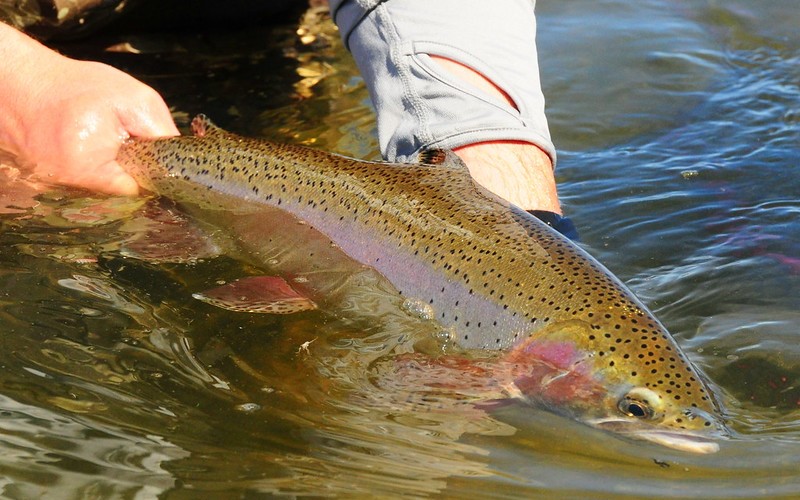The ethos of catch and release fishing is deeply ingrained in Idaho fly fishing culture. Letting trout live to grow, reproduce and fight another day is a key element that helps maintain the overall quality of fly fishing across the state.
That’s not to say that there’s anything wrong with keeping a few fish for the table. That, too, is a core element of the fishing experience for many anglers, and responsible harvest principles are just as important as catch and release fly fishing in Idaho. Today, let’s take a closer look at Idaho’s catch and release regulations, fish handling ethics, and how releasing fish helps protect fly fishing for future generations

Idaho Statewide Catch and Release Rules
Generally speaking, Idaho’s fishing season is open year-round on most waters. Certain lakes and rivers may be closed to fishing during certain seasons, or may be restricted to catch and release fishing only during all or part of the year.
It is common for trout streams to be catch and release only from December 1 through the Friday before Memorial Day weekend. During this period, fly fishing is allowed, but all trout must be returned immediately to the water unharmed.
Barbless Hook Rules in Idaho
Certain additional rules also apply if and when a body of water is limited to catch and release fishing, including regulations regarding the use of barbed hooks. On most catch and release waters, only single-point barbless hooks may be used. This rule is in place to minimize damage to fish and make it easier for them to be safely returned to the water.
Certain catch and release waters may also be restricted to fly fishing only, and live bait may also not be allowed on some waters. For complete fishing rules and regulations, including special rules for select waters, refer to the Idaho Fish & Game Fishing Seasons and Rules handbook.
How to Safely Release Trout in Idaho
Understanding how to handle trout safely so that they can be released is a cornerstone of effective catch and release fishing. Releasing a fish just to have it die from improper handling would be truly unfortunate. Here’s what you need to know about fish handling ethics, including gear tips for catch and release fly fishing in Idaho.
- Keep fish in the water. Making sure trout stay wet helps avoid oxygen depletion, which significantly reduces mortality rates.
- Don’t handle trout with dry hands. Contact with dry, rough surfaces, including anglers’ hands, sand and river rocks, can damage the scales and mucus layer that protect trout. Handle trout as little as possible, and only with clean, wet hands.
- Use a soft rubber net. Using a net helps reduce handling time and makes it easier for trout to stay in the water. Choose a net made of soft rubber material.
- Carry hook removal tools. Use a pair of fine needle-nosed pliers or forceps to gently remove hooks. When using barbless hooks, these tools often make it possible to remove hooks without handling trout at all.
- Be extra careful in warm waters. Trout become even more susceptible to damage, exhaustion and oxygen depletion as water temperatures rise. It is generally advised to avoid targeting trout at all if the water temp approaches 70 degrees.
Bull Trout Catch and Release Rules
Native to the cold, clear rivers and streams of Central and Northern Idaho, bull trout are regulated separately from other species of trout. In addition to being Idaho’s official state fish, bull trout are also a threatened species.
Although it was once entirely illegal to target bull trout in Idaho waters, anglers can now fish for bull trout. However, bull trout fishing is strictly catch and release, year-round, with no exceptions. Any bull trout caught in Idaho water must be released unharmed.
Top Catch and Release Rivers in Idaho
Some of the best fly fishing can be found in catch and release waters. These are some of the best places to find catch and release trout fishing in Idaho.
Henry’s Fork
Regulations vary by section on the legendary Henry’s Fork of the Snake River, so it’s important to read the rules carefully. One of the most renowned parts of the river is the Harriman Ranch section within Harriman State Park. This stretch is catch and release and fly fishing-only from June 15 through November 30, and closed to fishing from December 1 through June 14.
Lochsa River
Known for excellent westslope cutthroat trout fishing within the Selway Bitterroot Wilderness, the Lochsa River is catch and release from the Wilderness Gateway Campground Motor Bridge upstream to the confluence of Colt Killed Creek. This section also requires barbless hooks, and bait is prohibited.
Saint Joe River
Northern Idaho’s Saint Joe River is strictly catch and release for cutthroat trout (statewide regulations apply to all other species). Bait is prohibited, and barbless hooks are required above the confluence with the North Fork.
Big Wood River
A well-known fishery with abundant rainbow and brown trout in Central Idaho, the Big Wood River is divided into several sections with varying regulations. The fishing is strictly catch and release from the Highway 75 Bridge at milepost 122.2 upstream to the Highway 75 Bridge at milepost 136.2. This stretch is also closed to all fishing from April 1 through the Friday before Memorial Day weekend.
Kelly Creek
A tributary of the Clearwater River’s North Fork, Kelly Creek is a beautiful, off-the-beaten-path trout stream with exceptional cutthroat trout fishing within Nez Perce-Clearwater National Forest. All of Kelly Creek and its tributaries are completely catch and release for trout; barbless hooks are required, and bait is prohibited.
